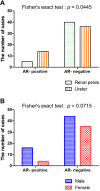Association of Androgen Receptor and PD-L1 Expression in Upper Urinary Tract Urothelial Carcinoma
- PMID: 38423597
- PMCID: PMC10905274
- DOI: 10.21873/cgp.20435
Association of Androgen Receptor and PD-L1 Expression in Upper Urinary Tract Urothelial Carcinoma
Abstract
Background/aim: The response to immune checkpoint inhibitors (ICIs) or enfortumab vedotin is limited in patients with upper urinary tract urothelial carcinoma (UTUC), and the development of new targeted therapy for UTUC is eagerly needed. Several biomarkers, including programmed cell death-ligand 1 (PD-L1), have already been reported as predictors of response to ICIs therapy for UTUC. Recently, several studies have shown that steroid hormone receptors, including the androgen receptor (AR), are associated with progression of urothelial carcinoma.
Materials and methods: We prepared tissue microarrays (TMA) from paraffin blocks of UTUC specimens in 99 non-metastatic UTUC patients who underwent radical nephroureterectomy. With these TMA sections, we performed immunohistochemical staining for PD-L1 and AR and examined PD-L1 and AR expression levels in tumor cells. In addition, we analyzed the correlation between these markers and clinical prognosis in UTUC cases.
Results: PD-L1 was positive in 24 (24%) of the 99 samples, whereas AR was positive in 20 (20%) patients. AR-negative samples had significantly higher PD-L1 expression level than that the AR-positive samples (mean value 4.70% versus 2.55%, p=0.0324). Among AR-positive cases, patients with absence of PD-L1 expression had significantly lower cancer-specific survival (CSS) than that in PD-L1 expression-positive cases (p=0.049), although PD-L1 expression had no significant impact on CSS in AR-negative cases (p=0.920).
Conclusion: Our findings suggest that AR is the promising target for UTUC treatment, especially in PD-L1-negative cases.
Keywords: AR; Androgen receptor; PD-L1; UTUC; programmed cell death ligand 1; upper urinary tract urothelial carcinoma.
Copyright © 2024, International Institute of Anticancer Research (Dr. George J. Delinasios), All rights reserved.
Conflict of interest statement
The Authors declare that they have no conflicts of interest or financial ties related to this study.
Figures




References
-
- Audenet F, Isharwal S, Cha EK, Donoghue MTA, Drill EN, Ostrovnaya I, Pietzak EJ, Sfakianos JP, Bagrodia A, Murugan P, Dalbagni G, Donahue TF, Rosenberg JE, Bajorin DF, Arcila ME, Hechtman JF, Berger MF, Taylor BS, Al-Ahmadie H, Iyer G, Bochner BH, Coleman JA, Solit DB. Clonal relatedness and mutational differences between upper tract and bladder urothelial carcinoma. Clin Cancer Res. 2019;25(3):967–976. doi: 10.1158/1078-0432.CCR-18-2039. - DOI - PMC - PubMed
-
- Fujii Y, Sato Y, Suzuki H, Kakiuchi N, Yoshizato T, Lenis AT, Maekawa S, Yokoyama A, Takeuchi Y, Inoue Y, Ochi Y, Shiozawa Y, Aoki K, Yoshida K, Kataoka K, Nakagawa MM, Nannya Y, Makishima H, Miyakawa J, Kawai T, Morikawa T, Shiraishi Y, Chiba K, Tanaka H, Nagae G, Sanada M, Sugihara E, Sato TA, Nakagawa T, Fukayama M, Ushiku T, Aburatani H, Miyano S, Coleman JA, Homma Y, Solit DB, Kume H, Ogawa S. Molecular classification and diagnostics of upper urinary tract urothelial carcinoma. Cancer Cell. 2021;39(6):793–809.e8. doi: 10.1016/j.ccell.2021.05.008. - DOI - PMC - PubMed
-
- Margulis V, Shariat SF, Matin SF, Kamat AM, Zigeuner R, Kikuchi E, Lotan Y, Weizer A, Raman JD, Wood CG, the Upper Tract Urothelial Carcinoma Collaboration Outcomes of radical nephroureterectomy: A series from the Upper Tract Urothelial Carcinoma Collaboration. Cancer. 2009;115(6):1224–1233. doi: 10.1002/cncr.24135. - DOI - PubMed
MeSH terms
Substances
LinkOut - more resources
Full Text Sources
Medical
Research Materials
